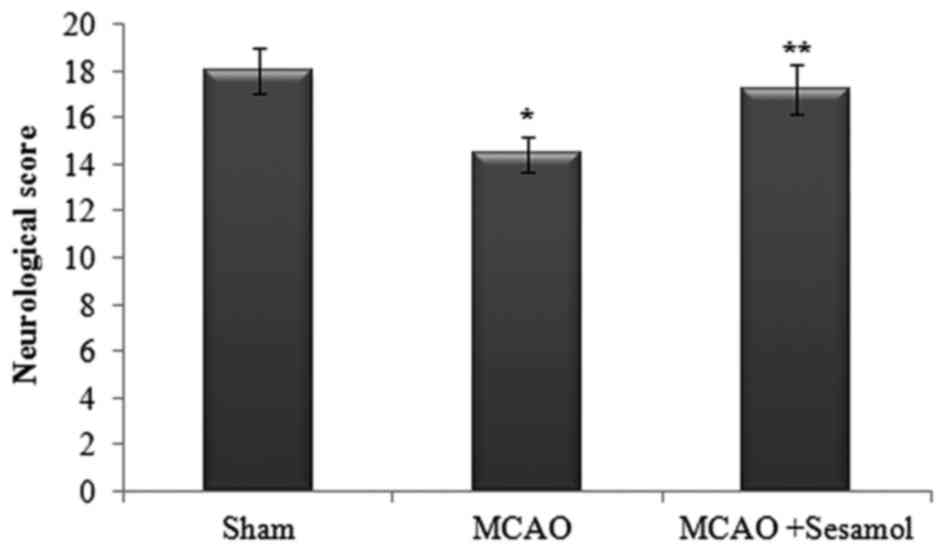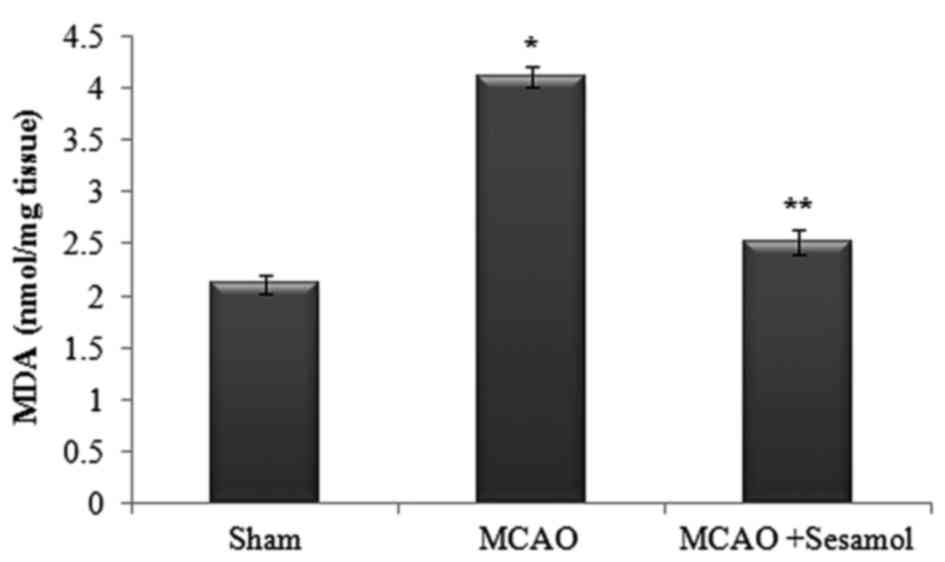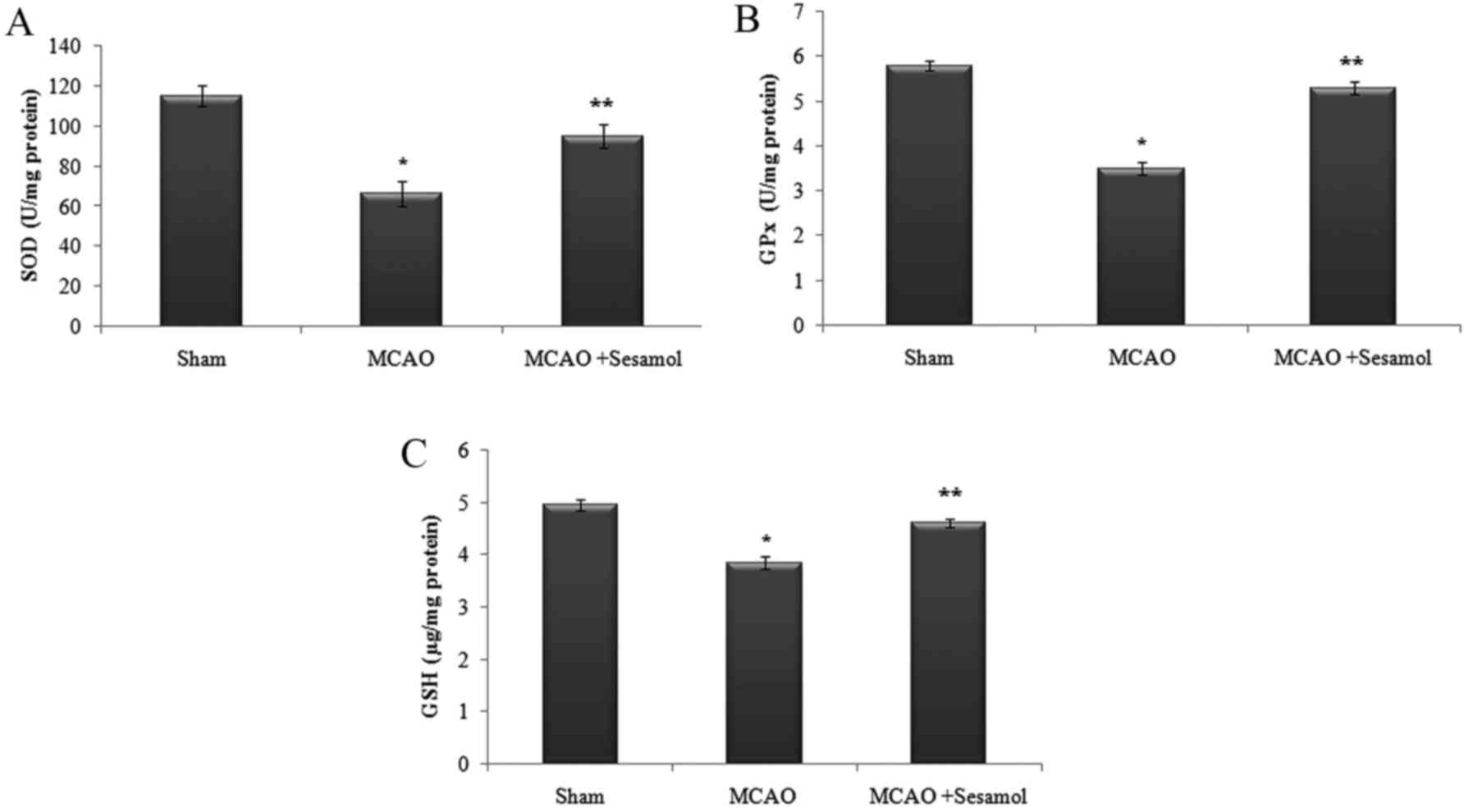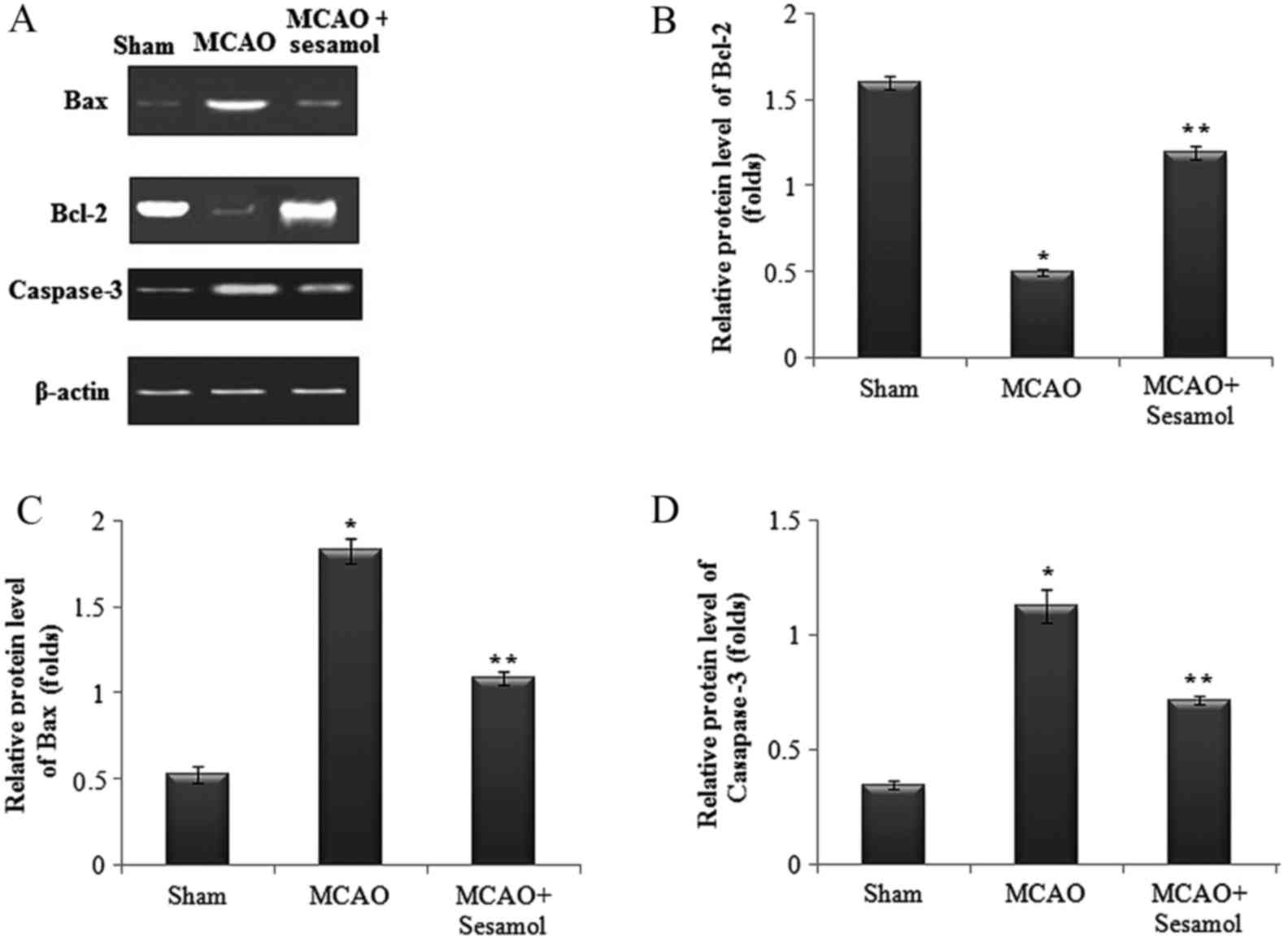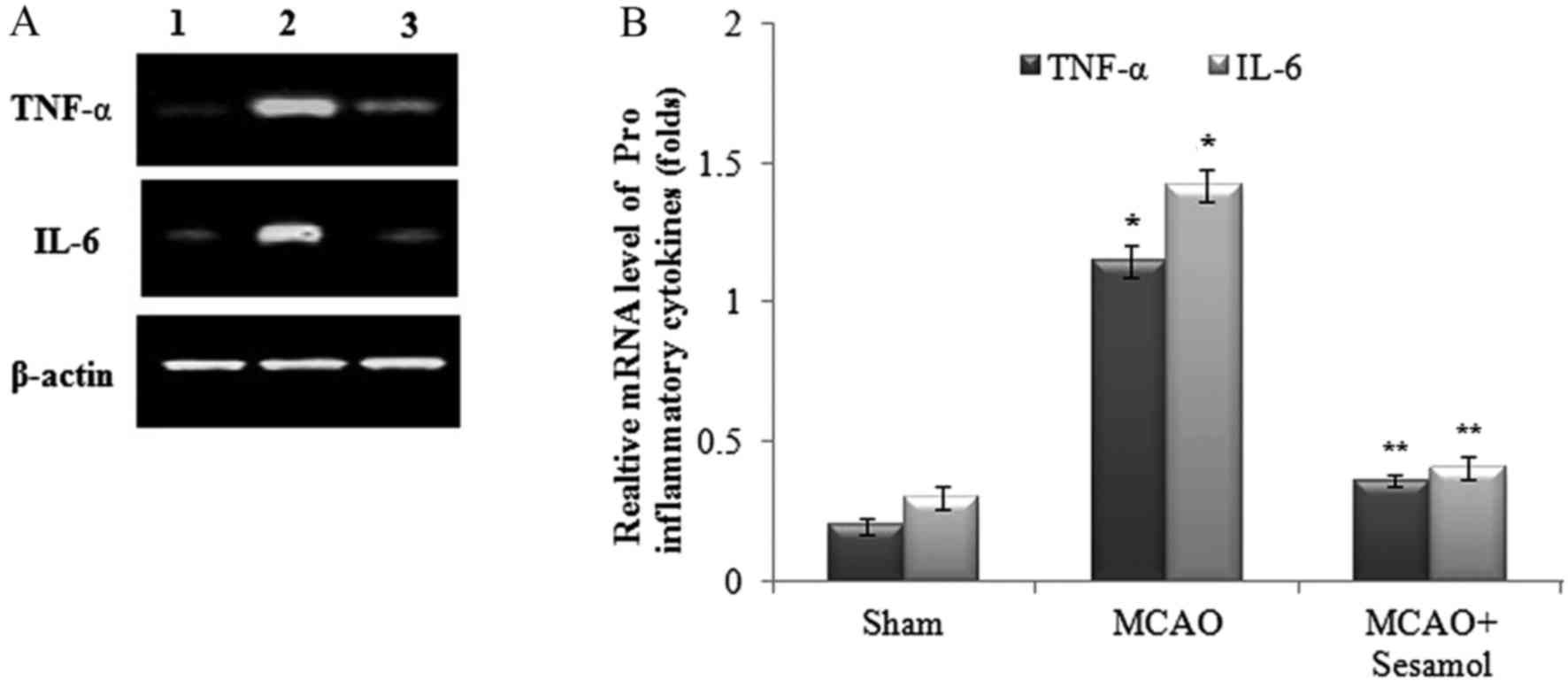Introduction
Globally, stroke is one of the leading causes of
mortality and a major contributing factor to adult disabilities,
and therefore there is a great interest in finding an effective
clinical treatment. Previous reports have suggested that several
biomechanisms may be associated with the pathology of cerebral
ischemic damage, such as ion imbalance, loss of ATP, increased
release of excitatory neurochemical transmitters, increased
generation of free radicals and apoptosis (1–3). In the
context of stroke, these events may induce irreversible brain
damage.
Oxidative stress is the first event in a sequence
leading to neuronal loss following cerebral ischemia reperfusion
(4). Essential cell components,
including DNA, protein and lipids, are subject to excessive
oxidative assault, leading to cell injury. Antioxidant defensive
molecules, such as superoxide dismutase, glutathione and catalase
are able to ameliorate the elevation of oxidants and therefore
reduce damage to tissues (5).
Apoptosis-mediated cell death due to DNA damage is a
major contributor to the tissue damage associated with cerebral
ischemia (6–9). During cerebral ischemia-induced
oxidative load, mitochondria release cytochrome c, which leads to
the activation of caspase-3 (10)
and is a prelude to formation of the apoptosome complex, which
encompasses apoptotic-protease activating factor-1, procaspase-9
and ATP (11). Apoptosomes induce
the activation of procaspase-9, followed by procaspase-3 (12). Finally, active caspase-3 is
associated with the process of DNA fragmentation that leads to cell
death (11).
B cell lymphoma (Bcl)-2 family-related proteins are
associated with regulation of the apoptotic process via the
activation/inactivation of protein systems (13). Bcl-2 inhibits apoptotic events in
various cells and is associated with reducing the overexpression of
proapoptotic factors (14,15) including Bcl-2-associated X protein
(Bax), which serves an important role in inducing apoptosis
(16,17).
Cerebral inflammation is important in the
progression of ischemic stroke (18–20). A
number of preclinical reports have suggested that, during stroke,
there is a marked elevation in the levels of pro-inflammatory
mediators tumor necrosis factor (TNF)-α, interleukin (IL)-1β and
IL-6 (21,22). Under these conditions, therapeutic
agents which are able to limit the formation of reactive oxygen
species (ROS) have been demonstrated to ameliorate brain damage
following stroke-like events.
Sesamol (5-hydroxy-1,3-benzodioxole or
3,4-methylenedioxyphenol) is the predominant active component of
sesame seed oil obtained from Sesamum indicum L. Sesamol has
previously been demonstrated to possess potent antioxidant activity
in ultraviolet and Fe3+/ascorbate-induced lipid
peroxidation in the rat brain (23).
Furthermore, sesamol appears to act as a neuroprotective agent and
exhibits a multitude of biological effects such as
hepatoprotective, anti-inflammatory, anti-cancer and anti-aging
properties (23–26). Based on this, the present study aimed
to evaluate the efficacy of sesamol in alleviating cerebral
ischemic injury in a rat model of middle cerebral artery occlusion
(MCAO).
Materials and methods
Animals
A total of 30 male Sprague Dawley rats with a weight
range of 170–200 g were obtained from the animal facility of
Shandong University (Shandong, China). Rats were housed under
standard laboratory conditions with relative humidity 55±5%,
temperature 25±2°C, a 12-h light/dark cycle. Rats were fed standard
diet pellets and water was provided ad libitum. Rats were randomly
divided into three groups (n=10 per group): Sham group; MCAO group,
rats underwent MCAO procedure and treated with normal saline
vehicle; and the MCAO+sesamol group, underwent MCAO procedure and
treated with 25 mg/kg/day sesamol. Sesamol was administered for
seven consecutive days prior to the induction of MCAO.
Sham-operated and MCAO vehicle groups were administered saline
under the same conditions.
MCAO model
Focal cerebral ischemic injuries were induced via an
intraluminal filament surgical procedure, as previously described
(27). In brief, rats were
anesthetized via intraperitoneal administration of 10% chloral
hydrate (350 mg; Sigma-Aldrich; Merck Millipore, Darmstadt,
Germany). Under aseptic conditions, a small incision was made in
the neck and the external carotid artery (ECA) and internal carotid
artery (ICA) were exposed and isolated. A sterile nylon thread (15
mm long and 0.15 mm in diameter) was introduced from the ECA into
the ICA to occlude the origin of the left middle cerebral artery.
The procedure was terminated when mild resistance was felt. Nylon
thread was removed 2 h post-surgery to restore blood supply for 24
h reperfusion.
Neurological evaluation
Neurological evaluation was performed at 24 h
post-surgery. An established scoring system reported by Garcia
et al (28) was used, in
which six individual tests are performed and their scores are added
together. The six tests conducted evaluated spontaneous activity,
symmetry in limb movement, forepaw outstretching, climbing, body
proprioception, and response to vibrissae stimulation. Neurological
deficits were assessed by a ‘blinded’ assessor. Each test was
scored from 0 to 3, with a minimum neurological score of 0 and a
maximum of 18. A lower score was considered to represent serious
neurological deficits. All sham-operated animals had a score of 18
(28).
Evaluation of oxidative stress
Following neurological evaluation, rats were
sacrificed via intraperitoneal administration of xylazine and
ketamine (10 and 75 mg/kg; Sigma-Aldrich; Merck Millipore). The
ischemic hemispheres (n=10 per group) were harvested and
homogenized in 4°C Tris buffer (pH 7.4; Sima-Aldrich; Merck
Millipore). The homogenate was centrifuged at 2,000 × g at 4°C for
15 min and the resulting supernatant was evaluated to determine the
content of malondialdehyde (MDA), activity of superoxide dismutase
(SOD) and glutathione peroxidase (GPx), and levels of reduced
glutathione (GSH) using a spectrophotometer (UV-2600; Shimadzu
Corporation, Kyoto, Japan) and assay kits according to the
manufacturer's protocol (SOD, cat. no. A001-1; MDA, A003-1; GPx,
A005; GSH, A006; Nanjing Jiancheng Bioengineering Institute,
Nanjing, China).
Measurement of apoptotic protein
expression using western blot analysis
Ischemic hemispheres (n=5 per group) were harvested,
weighed and homogenized in radioimmunoprecipitation assay buffer
(Abcam, Cambridge, UK) containing 0.22% β-glycerophosphate, 10%
tergitol-NP40, 0.18% sodium orthovanadate, 5% sodium deoxycholate,
0.38% EGTA, 1% SDS, 6.1% Tris, 0.29% EDTA, 8.8% sodium chloride,
1.12% sodium pyrophosphate decahydrate (pH 7.5), at 4°C. The lysate
was collected and placed in an orbital shaker for 2 h at 4°C.
Solubilised proteins were collected from the supernatant following
centrifugation at 16,000 × g for 20 min at 4°C, and 20 µg samples
were subjected to 10% SDS-PAGE (Sigma-Aldrich; Merck Millipore) and
electrotransferred to nitrocelluose membranes (pore size, 0.45 mm;
Sigma-Aldrich; Merck Millipore) to measure Caspase-3, Bax and
Bcl-2. Membranes were blocked using 5% nonfat dry milk dissolved in
0.05 mol/l TBS containing 200 mmol/l (pH 7.4), and washed three
times in TBS (30 min each). The primary antibodies used in the
study were as follows; Caspase-3 (1:1,000; cat. no. 19677-1-AP),
Bax, (1:1,000; cat. no. 50599-2-Ig) and Bcl-2 (1:750; cat. no.
12789-1-AP; all ProteinTech Group, Inc., Chicago, IL, USA). The
blot was washed with TBS and incubated for 1 h at room temperature
with goat anti-mouse antibody conjugated to peroxidase (1:1,500;
cat. no. sc-2005; Santa Cruz Biotechnology, Inc., Dallas, TX, USA).
β-actin (1:5,000; Santa Cruz Biotechnology, Inc.) was used as a
control. Binding of the antibodies was detected using an ECL
detection kit (Applygen Technologies, Inc., Beijing, China) and
protein bands were visualized using the Gel Doc XR system (Bio-Rad
Laboratories, Inc., Hercules, CA, USA) and quantified using Image J
software (version 1.50; National Institutes of Health, Bethesda,
MD, USA). All blots were performed in triplicate.
Analysis of inflammatory cytokine gene
expression by reverse transcription-quantitative polymerase chain
reaction
RNA was isolated from the frozen rat ischemic
hemispheres and purified using RNase (Sigma-Aldrich; Merck
Millipore) according to the manufacturer's protocol. Genomic DNA
was removed by the addition of 10 µl 10X DNase buffer and 1 µl
DNase I (both Sigma-Aldrich; Merck Millipore) to the RNA sample (2
µl), which was subsequently incubated for 30 min at 37°C. cDNA was
synthesized from 1 µg of the purified RNA sample using oligo-dT
primers, dNTPs, DTT, RNase inhibitor and reverse transcriptase (all
Santa Cruz Biotechnology, Inc.) according to the manufacturer's
protocol. The oligonucleotide primers used are displayed in
Table I. A total of 1 µl forward
primer and 1 µl reverse primer were added to 10 µl MasterMix (Santa
Cruz Biotechnology, Inc.), and diluted with water to a total volume
of 15 µl. An additional 0.5 ml MasterMix was added followed by 1 µl
cDNA, and the mixture was vortexed prior to PCR. The PCR reactions
were performed using a LightCycler 480 Real-Time PCR System (Roche
Diagnostics, Basel, Switzerland) and consisted of an initial
denaturation at 95°C for 3 min, followed by 35 cycles at 95°C for
50 sec, 58°C for 45 sec and 72°C for 50 sec. The reactions were
terminated via an elongation step at 72°C for 7 min. The integrated
densities value was analyzed using a computerized image analysis
system (Motic Images Advanced 3.2; Motic Instruments, Inc.,
Richmond, BC, Canada). Data was quantified via the
2−ΔΔCq method (29). All tests were performed in
triplicate.
 | Table I.List of primers used for reverse
transcription-quantitative polymerase chain reaction. |
Table I.
List of primers used for reverse
transcription-quantitative polymerase chain reaction.
| Gene | Primer
sequence |
|---|
| IL-6 | F:
5′-ATCTGCCCTTCAGGAACAGC-3′ |
|
| R:
5′-AGCCTCCGACTTGTGAAGTG 3′ |
| TNF-α | F: 5′-CTTCTC CTT
CCT GAT CGT GG-3′ |
|
| R:
5′-GCTGGTTATCTCTCAGCTCCA-3′ |
| β-actin | F:
5′-GTGGGGCGCCCAGGCACCA-3′ |
|
| R:
5′-GCTCGGCCGTGGTGGTGAAGC-3′ |
Statistical analysis
Data are presented as the mean ± standard error of
the mean. Statistical analysis of the data was performed using
SPSS, version 13.0 (SPSS, Inc., Chicago, IL, USA). All data was
analysed by one-way analysis of variance followed by the Tukey test
for multiple comparisons. P<0.05 was considered to indicate a
statistically significant difference.
Results
Effect of sesamol and MCAO on
neurological score
Neurological scores were significantly decreased in
the MCAO group compared with the sham group (P<0.05). Following
sesamol treatment, neurological deficits were significantly reduced
compared with those in the MCAO group (P<0.05; Fig. 1).
Effect of sesamol and MCAO on lipid
peroxidation
Lipid peroxidation in the ischemic hemisphere was
quantified by evaluating MDA levels (Fig. 2). The brain level of MDA in rats from
the MCAO group was significantly higher than in the sham rat group
(P<0.05), indicating elevated in vivo oxidative stress in
the brain. This increase was significantly decreased by treatment
with sesamol compared with MCAO rats (P<0.05).
Effect of sesamol and MCAO on
antioxidant level
In the present study, there was a significant
decline in the level of antioxidants (GSH, SOD and GPx) following
the induction of MCAO compared with the sham rats (P<0.05).
Administration of sesamol significantly (P<0.05) increased the
level of antioxidants in the brain through its anti-lipid
peroxidative effect (Fig. 3).
Influence of sesamol on the expression
of apoptosis-related proteins following MCAO injury
Protein levels of Caspase-3, Bax and Bcl-2 in
ischemic cortex tissues were assesed using western blot analysis
following 24 h of reperfusion (Fig.
4A). A significant upregulation in protein expression of
Caspase-3 and Bax, and a significant downregulation in Bcl-2
protein expression were observed in the MCAO group (all P<0.05).
However, rats treated with sesamol exhibited a significant
downregulation in Caspase-3 and Bax expression and a significant
upregulation in Bcl-2 protein expression (P<0.05; Fig. 4B-D).
Effect of MCAO and sesamol on cytokine
mRNA expression profile
In the present study, MCAO groups exhibited a
significant upregulation in mRNA expression of the proinflammatory
cytokines TNF-α and IL-6 (P<0.05), whereas inflammation was
mitigated in rats treated with sesamol due to a significant
downregulation of the mRNA expression of TNF-α and IL-6 (P<0.05;
Fig. 5A). Furthermore, the relative
expression levels of TNF-α and IL-6 were significantly higher in
the MCAO group compared with the control group (P<0.05), and
sesamol treatment induced a significant reduction in the expression
of proinflammatory cytokines (P<0.05; Fig. 5B).
Discussion
Stroke is a leading cause of morbidity and mortality
worldwide (30,31). The reduction of blood flow to the
brain that occurs during cerebral ischemia may aggravate the
necrosis of neuronal and brain cells (32,33). It
has been demonstrated that various pathological mechanisms, such as
elevation of ROS levels, inhibition of the detoxification cascade
and the loss of antioxidant reserve enzymes are associated with the
progression of cerebral ischemia (34,35).
Preclinical MCAO models exhibit an identical pattern of ischemic
brain damage as is observed in human patients who have suffered an
ischemic stroke (36). The aim of
the present study was to evaluate the protective impact of sesamol
on focal cerebral ischemic reperfusion injury.
In the present study, MCAO rats exhibited a
significant reduction in the voluntary motor activity and the
flexion tests. This may be associated with excessive free radical
generation in the hippocampus and cortical areas, which are
responsible for motor activities (37). Sesamol administration was able to
significantly reduce the neurological deficts and restore the brain
motor activities, which supports the findings of a previous report
(38).
The ROS generated during cerebral ischemia are able
to oxidize biomolecules such as lipids, which further increases
cell toxicity and brain dysfunction. The detrimental effects of
free radicals on lipids lead to the formation of the final lipid
peroxidation product MDA, which is a toxic adduct that induces
neuronal cell death and loss of brain activity (39). In the present study, sesamol
treatment was able to reduce MDA levels in MCAO rats, which may be
due to the inhibitory effect of sesamol on oxidative damage
(40). GSH, a vital intracellular
non-protein thiol, acts as a scavenger of free radicals (41). Previous studies have demonstrated
that cerebral ischemia mediated lipid peroxidation is concurrent
with GSH depletion in brain tissue (42–44).
Furthermore, it has previously been suggested that antioxidant
enzymes such as SOD and GPx may serve a key role in the regulation
of redox homeostasis in tissues (45,46). In
the present study, MCAO groups displayed significant reductions in,
SOD and GPx levels in the brain ischemic tissue, compared with a
sham group. Treatment with sesamol was able to restore depleted
antioxidant levels due to its potent antioxidant activity and
anti-lipid peroxidative effect. The effect of sesamol may be
attributed to the presence of free phenolic hydroxyl groups
(47).
The levels of proinflammatory cytokines such as
TNF-α and IL-1β are markedly higher during ischemic stroke, which
also contributes to brain damage associated with stroke (48,49).
Furthermore, elevated levels of proinflammatory cytokines are able
to augment the expression of intracellular adhesion molecule-1 and
E-selectin in leukocytes, and enhance the adhesion and
transendothelial migration of leukocytes (19). These mechanisms induce an
inflammatory cascade, which leads to a loss of blood-brain barrier
integrity and induces fluid accumulation in the brain, resulting in
neuronal cell death (50). In the
present study, MCAO rats exhibited an upregulation in TNF-α and
IL-1β mRNA expression in ischemic brain tissue. These results are
corroborated by previous studies, which reported that exacerbated
TNF-α and IL-1β levels may be important factors in reperfusion
injury following transient brain ischemia (51); however, sesamol treatment
significantly downregulated the expression of proinflammatory
cytokines via its anti-inflammatory activity (52,53).
Apoptosis serves an important role in the etiology
of cerebral ischemia reperfusion injury via activating the
apoptotis-related protein cascade located within apoptotic cells
(54,55). Bcl-2 family-related proteins are also
associated with the regulation of major apoptotic signal
transduction pathways and are able to cause irreversible cell
damage (56,57), and the Bcl-2/Bax ratio is important
in the regulation of apoptotic cell death (58). Furthermore, Caspase-3 is the primary
protein associated with apoptosis and is vital for inducing DNA
fragmentation and apoptosis-related cell morphology changes
(59,60). In the present study, MCAO rats
exhibited an upregulation in Caspase-3 and Bax expression, and a
downregulation in Bcl-2 expression in ischemic tissue. Sesamol
treatment was able to restore the expression of apoptotic markers
to normal levels and therefore prevent apoptosis from occurring.
The anti-apoptotic activity of sesamol has been suggested by
previous results (61,62).
In conclusion, the results of the present study
suggest that the neuroprotective effect of sesamol on cerebral
tissue exposed to MCAO-reperfusion and ischemic damage in rats is
mainly due to the inhibition of neurological deficits and lipid
peroxidation, the restoration of antioxidants and the mitigation of
inflammation and apoptosis responses. Based on the results of the
present study, sesamol may be a suitable candidate for the clinical
treatment of various brain ischemic conditions resulting from
oxidative stress. Furthermore, future research into the molecular
mechanisms of sesamol may reveal the extent of its anti-stroke
effect.
References
|
1
|
Dirnagl U, Iadecola C and Moskowitz MA:
Pathobiology of ischaemic stroke: An integrated view. Trends
Neurosci. 22:391–397. 1999. View Article : Google Scholar : PubMed/NCBI
|
|
2
|
Durukan A and Tatlisumak T: Acute ischemic
stroke: Overview of major experimental rodent models,
pathophysiology, and therapy of focal cerebral ischemia. Pharmacol
Biochem Behav. 87:179–197. 2007. View Article : Google Scholar : PubMed/NCBI
|
|
3
|
Lapchak PA and Araujo DM: Advances in
ischemic stroke treatment: Neuroprotective and combination
therapies. Exp Opin Emer Drugs. 12:97–112. 2007. View Article : Google Scholar
|
|
4
|
Chan PH: Reactive oxygen radicals in
signaling and damage in the ischemic brain. J Cereb Blood Flow
Metab. 21:2–14. 2001. View Article : Google Scholar : PubMed/NCBI
|
|
5
|
Chen H, Yoshioka H, Kim GS, Jung JE, Okami
N, Sakata H, Maier CM, Narasimhan P, Goeders CE and Chan PH:
Oxidative stress in ischemic brain damage: Mechanisms of cell death
and potential molecular targets for neuroprotection. Antioxid Redox
Signal. 14:1505–1517. 2011. View Article : Google Scholar : PubMed/NCBI
|
|
6
|
Kawaguchi M, Drummond JC, Cole DJ, Kelly
PJ, Spurlock MP and Patel PM: Effect of isoflurane on neuronal
apoptosis in rats subjected to focal cerebral ischemia. Anesth
Analg. 98:798–805. 2004. View Article : Google Scholar : PubMed/NCBI
|
|
7
|
Liu R, Gao M, Yang ZH and Du GH:
Pinocembrin protects rat brain against oxidation and apoptosis
induced by ischemia-reperfusion both in vivo and in vitro. Brain
Res. 1216:104–115. 2008. View Article : Google Scholar : PubMed/NCBI
|
|
8
|
Wang W, Xu J and Li L, Wang P, Ji X, Ai H,
Zhang L and Li L: Neuroprotective effect of morroniside on focal
cerebral ischemia in rats. Brain Res Bull. 83:196–201. 2010.
View Article : Google Scholar : PubMed/NCBI
|
|
9
|
Lu Y, Zhang J, Ma B, Li K, Li X, Bai H,
Yang Q, Zhu X, Ben J and Chen Q: Glycine attenuates cerebral
ischemia/reperfusion injury by inhibiting neuronal apoptosis in
mice. Neurochem Int. 61:649–658. 2012. View Article : Google Scholar : PubMed/NCBI
|
|
10
|
Broughton BR, Reutens DC and Sobey CG:
Apoptotic mechanisms after cerebral ischemia. Stroke. 40:e331–e339.
2009. View Article : Google Scholar : PubMed/NCBI
|
|
11
|
Wang X: The expanding role of mitochondria
in apoptosis. Genes Dev. 15:2922–2933. 2001.PubMed/NCBI
|
|
12
|
Li P, Nijhawan D, Budihardio I,
Srinivasula SM, Ahmad M, Alnemri ES and Wang X: Cytochrome c and
dATP dependent formation of Apaf-1/caspase-9 complex initiates an
apoptotic protease cascade. Cell. 91:479–489. 1997. View Article : Google Scholar : PubMed/NCBI
|
|
13
|
Elmore S: Apoptosis: A review of
programmed cell death. Toxicol Pathol. 35:495–516. 2007. View Article : Google Scholar : PubMed/NCBI
|
|
14
|
Gross A, McDonnell JM and Korsmeyer SJ:
BCL-2 family members and the mitochondria in apoptosis. Genes Dev.
13:1899–1911. 1999. View Article : Google Scholar : PubMed/NCBI
|
|
15
|
Shigeomi S, Narita M and Yoshihide T:
Bcl-2 family proteins regulate the release of apoptogenic
cytochrome c by the mitochondrial channel VDAC. Nature.
399:483–487. 1999. View
Article : Google Scholar : PubMed/NCBI
|
|
16
|
Hsu YT, Wolter KG and Youle RJ:
Cytosol-to-membrane redistribution of Bax and Bcl-X(L) during
apoptosis. Proc Nat Acad Sci USA. 94:pp. 3668–3672. 1997;
View Article : Google Scholar : PubMed/NCBI
|
|
17
|
Martinou JC and Youle RJ: Mitochondria in
apoptosis: Bcl-2 family members and mitochondrial dynamics. Dev
Cell. 21:92–101. 2011. View Article : Google Scholar : PubMed/NCBI
|
|
18
|
Amantea D, Nappi G, Bernardi G, Bagetta G
and Corasaniti MT: Post-ischemic brain damage: Pathophysiology and
role of inflammatory mediators. FEBS J. 276:13–26. 2009. View Article : Google Scholar : PubMed/NCBI
|
|
19
|
Jin R, Yang G and Li G: Inflammatory
mechanisms in ischemic stroke: Role of inflammatory cells. J Leukoc
Biol. 87:779–789. 2010. View Article : Google Scholar : PubMed/NCBI
|
|
20
|
Kleinig TJ and Vink R: Suppression of
inflammation in ischemic and hemorrhagic stroke: Therapeutic
options. Curr Opin Neurol. 22:294–301. 2009. View Article : Google Scholar : PubMed/NCBI
|
|
21
|
Wang Q, Tang XN and Yenari MA: The
inflammatory response in stroke. J Neuroimmunol. 184:53–68. 2007.
View Article : Google Scholar : PubMed/NCBI
|
|
22
|
del Zoppo G, Ginis I, Hallenbeck JM,
Iadecola C, Wang X and Feuerstein GZ: Inflammation and stroke:
Putative role for cytokines, adhesion molecules and iNOS in brain
response to ischemia. Brain Pathol. 10:95–112. 2000. View Article : Google Scholar : PubMed/NCBI
|
|
23
|
Prasad NR, Mahesh T, Menon VP, Jeevanram
RK and Pugalendi KV: Photo protective effect of sesamol on
UVB-radiation induced oxidative stress inhuman blood lymphocytes in
vitro. Environ Toxicol Pharmacol. 20:1–5. 2005. View Article : Google Scholar : PubMed/NCBI
|
|
24
|
Hou RC, Chen YS, Chen CH, Chen YH and Jeng
KC: Protective effect of 1,2,4-benzenetriol on LPS-induced NO
production by BV2 microglial cells. J Biomed Sci. 13:89–99. 2006.
View Article : Google Scholar : PubMed/NCBI
|
|
25
|
Hsu DZ, Chen KT, Li YH, Chuang YC and Liu
MY: Sesamol delays mortality and attenuates hepatic injury after
cecal ligation and puncture in rats: Role of oxidative stress.
Shock. 25:528–532. 2006. View Article : Google Scholar : PubMed/NCBI
|
|
26
|
Sharma S and Kaur IP: Development and
evaluation of sesamol as an antiaging agent. Int J Dermatol.
45:200–208. 2006. View Article : Google Scholar : PubMed/NCBI
|
|
27
|
Longa EZ, Weinstein PR, Carlson S and
Cummins R: Reversible middle cerebral artery occlusion without
craniectomy in rats. Stroke. 20:84–91. 1989. View Article : Google Scholar : PubMed/NCBI
|
|
28
|
Garcia J, Wagner S, Liu KF and Hu XJ:
Neurological deficit and extent of neuronal necrosis attributable
to middle cerebral artery occlusion in rats. Statistical
validation. Stroke. 26:627–635. 1995. View Article : Google Scholar : PubMed/NCBI
|
|
29
|
Livak KJ and Schmittgen TD: Analysis of
relative gene expression data using real-time quantitative PCR and
the 2(−Delta Delta C (T)) Method. Methods. 25:402–408. 2001.
View Article : Google Scholar : PubMed/NCBI
|
|
30
|
Bora KS and Sharma A: Neuroprotective
effect of Artemisia absinthium L. on focal ischemia and
reperfusion-induced cerebral injury. J Ethnopharmacol. 129:403–409.
2010. View Article : Google Scholar : PubMed/NCBI
|
|
31
|
Hankey GJ: The global and regional burden
of stroke. Lancet Global Health. 1:e239–e240. 2013. View Article : Google Scholar : PubMed/NCBI
|
|
32
|
Traystman RJ: Animal models of focal and
global cerebral ischemia. ILARJ. 44:85–95. 2003. View Article : Google Scholar
|
|
33
|
Park SJ, Nam KW, Lee HJ, Cho EY, Koo U and
Mar W: Neuroprotective effects of an alkaloid-free ethyl acetate
extract from the root of Sophora flavescens Ait. against focal
cerebral ischemia in rats. Phytomedicine. 16:1042–1051. 2009.
View Article : Google Scholar : PubMed/NCBI
|
|
34
|
Kutsuna S, Tsuruta R, Fujita M, Todani M,
Yagi T, Ogino Y, Igarashi M, Takahashi K, Izumi T, Kasaoka S, et
al: Cholinergic agonist physostigmine suppresses excessive
superoxide anion radical generation in blood, oxidative stress,
early inflammation, and endothelial injury in rats with forebrain
ischemia/reperfusion. Brain Res. 1313:242–249. 2010. View Article : Google Scholar : PubMed/NCBI
|
|
35
|
Pratap R, Pillai KK, Khanam R, Islam F,
Ahmad SJ and Akhtar M: Protective effect of irbesartan, an
angiotensin II receptor antagonist, alone and in combination with
aspirin on middle cerebral artery occlusion model of focal cerebral
ischemia in rats. Hum Exp Toxicol. 30:354–362. 2011. View Article : Google Scholar : PubMed/NCBI
|
|
36
|
Ginsberg MD and Busto R: Rodent models of
cerebral ischemia. Stroke. 20:1627–1642. 1989. View Article : Google Scholar : PubMed/NCBI
|
|
37
|
Kumar P, Kalonia H and Kumar A: Sesamol
attenuate 3-nitropropionic acid-induced Huntington-like behavioral,
biochemical, and cellular alterations in rats. J Asian Nat Prod
Res. 11:439–450. 2009. View Article : Google Scholar : PubMed/NCBI
|
|
38
|
Cohen GM: Caspases: The executioners of
apoptosis. Biochem J. 326:1–16. 1997. View Article : Google Scholar : PubMed/NCBI
|
|
39
|
Serteser M, Ozben T, Gumuslu S, Balkan S
and Balkan E: Lipid peroxidation in rat brain during focal cerebral
ischemia: Prevention of malondialdehyde and lipid conjugated diene
production by a novel antiepileptic, lamotrigine. Neurotoxicology.
23:111–119. 2002. View Article : Google Scholar : PubMed/NCBI
|
|
40
|
Misra S, Tiwari V, Kuhad A and Chopra K:
Modulation of nitrergic pathway by sesamol prevents cognitive
deficits and associated biochemical alterations in
intracerebroventricular streptozotocin administered rats. Eur J
Pharmacol. 659:177–186. 2011. View Article : Google Scholar : PubMed/NCBI
|
|
41
|
Liu Z, Li P, Zhao D, Tang H and Guo J:
Protective effect of extract of Cordyceps sinensis in middle
cerebral artery occlusion-induced focal cerebral ischemia in rats.
Behav Brain Funct. 6:612010. View Article : Google Scholar : PubMed/NCBI
|
|
42
|
Chan PH: Reactive oxygen radicals in
signaling and damage in the ischemic brain. J Cereb Blood Metab.
21:2–14. 2001. View Article : Google Scholar
|
|
43
|
Al-Omar FA, Nagi MN, Abdulgadir MM, Al
Joni KS and Al-Majed AA: Immediate and delayed treatments with
curcumin prevent forebrain ischemia-induced neuronal damage and
oxidative insult in the rat hippocampus. Neurochem Res. 31:611–618.
2006. View Article : Google Scholar : PubMed/NCBI
|
|
44
|
Saleem S, Ahmad M, Ahmad AS, Yousuf S,
Ansari MA, Khan MB, Ishrat T and Islam F: Behavioral and histologic
neuroprotection of aqueous garlic extract after reversible focal
cerebral ischemia. J Med Food. 9:537–544. 2006. View Article : Google Scholar : PubMed/NCBI
|
|
45
|
Gilgun-Sherki Y, Rosenbaum Z, Melamed E
and Offen D: Antioxidant therapy in acute central nervous system
injury: Current state. Pharmacol Rev. 54:271–284. 2002. View Article : Google Scholar : PubMed/NCBI
|
|
46
|
Lo EH, Dalkara T and Moskowitz MA:
Mechanisms, challenges and opportunities instroke. Nat Rev
Neurosci. 4:399–415. 2003. View Article : Google Scholar : PubMed/NCBI
|
|
47
|
Uchida M, Nakajin S, Toyoshima S and
Shinoda M: Antioxidative effect of sesamol and related compounds on
lipid peroxidation. Biol Pharm Bull. 19:623–626. 1996. View Article : Google Scholar : PubMed/NCBI
|
|
48
|
Hallenbeck JM: The many faces of tumor
necrosis factor in stroke. Nat Med. 8:1363–1368. 2002. View Article : Google Scholar : PubMed/NCBI
|
|
49
|
Rothwell N, Allan S and Toulmond S: The
role of interleukin 1 in acute neu-rodegeneration and stroke:
Pathophysiological and therapeutic implications. J Clin Invest.
100:2648–2652. 1997. View Article : Google Scholar : PubMed/NCBI
|
|
50
|
Huang J, Upadhyay UM and Tamargo RJ:
Inflammation in stroke and focal cerebral ischemia. Surg Neurol.
66:232–245. 2006. View Article : Google Scholar : PubMed/NCBI
|
|
51
|
Tang NY, Liu CH, Hsieh CT and Hsieh CL:
The anti-inflammatory effect of paeoniflorin on cerebral infarction
induced by ischemia-reperfusion injury in Sprague-Dawley rats. Am J
Chin Med. 38:51–64. 2010. View Article : Google Scholar : PubMed/NCBI
|
|
52
|
Hsu DZ, Chen YW, Chu PY, Periasamy S and
Liu MY: Protective effect of 3,4-methylenedioxyphenol (Sesamol) on
stress-related mucosal disease in rats. Biomed Res Int.
2013:4818272013. View Article : Google Scholar : PubMed/NCBI
|
|
53
|
Hassanzadeh P, Arbabi E and Rostami F: The
ameliorative effects of sesamol against seizures, cognitive
impairment and oxidative stress in the experimental model of
epilepsy. Iran J Basic Med Sci. 17:100–107. 2014.PubMed/NCBI
|
|
54
|
Galluzzi L, Morselli E, Kepp O and Kroemer
G: Targeting post-mitochondrial effectors of apoptosis for
neuroprotection. Biochim Biophys Acta. 1787:402–413. 2009.
View Article : Google Scholar : PubMed/NCBI
|
|
55
|
Nakka VP, Gusain A, Mehta SL and Raghubir
R: Molecular mechanisms of apoptosis in cerebral ischemia: Multiple
neuroprotective opportunities. Mol Neurobiol. 37:7–382. 2008.
View Article : Google Scholar : PubMed/NCBI
|
|
56
|
Weyhenmeyer B, Murphy AC, Prehn JH and
Murphy BM: Targeting the anti-apoptotic Bcl-2 family members for
the treatment of cancer. Exp Oncol. 34:192–199. 2012.PubMed/NCBI
|
|
57
|
Yang TM, Barbone D, Fennell DA and
Broaddus VC: Bcl-2 family proteins contribute to apoptotic
resistance in lung cancer multicellular spheroids. Am J Respir Cell
Mol Biol. 41:14–23. 2009. View Article : Google Scholar : PubMed/NCBI
|
|
58
|
Bar-Am O, Weinreb O, Amit T and Youdim MB:
Regulation of Bcl-2 family proteins, neurotrophic factors, and APP
processing in the neuro rescue activity of propargylamine. FASEB J.
19:1899–1901. 2005.PubMed/NCBI
|
|
59
|
Jänicke RU, Sprengart ML, Wati MR and
Porter AG: Caspase-3 is required for DNA fragmentation and
morphological changes associated with apoptosis. J Biol Chem.
273:9357–9360. 1998. View Article : Google Scholar : PubMed/NCBI
|
|
60
|
Ramachandran S and Prasad NR: Sesamol
modulates ultraviolet-B-induced apoptotic and inflammatory
signalling in human skin dermal fibroblasts. Int J Nutr Pharmacol
Neurol Dis. 2:31–39. 2012. View Article : Google Scholar
|
|
61
|
Raza SS, Khan MM, Ahmad A, Ashafaq M,
Khuwaja G, Tabassum R, Javed H, Siddiqui MS, Safhi MM and Islam F:
Hesperidin ameliorates functional and histological outcome and
reduces neuroinflammation in experimental stroke. Brain Res.
1420:93–105. 2011. View Article : Google Scholar : PubMed/NCBI
|
|
62
|
Nayak PG, Paul P, Bansal P, Kutty NG and
Pai KS: Sesamol prevents doxorubicin-induced oxidative damage and
toxicity on H9c2 cardiomyoblasts. J Pharm Pharmacol. 65:1083–1093.
2013. View Article : Google Scholar : PubMed/NCBI
|















